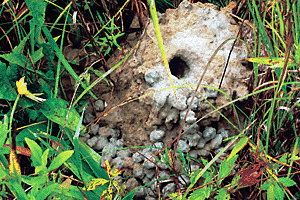The life cycle of the massasauga is a very interesting thing to
say the least. These snakes reproduce every two to three
years, depending on how quickly the females can generate enough
body fat to support any developing young inside them.  The young
don't actually receive any nutrients from the mother while they
are developing; they receive everything they need from the yolk
of the egg they are inside of. The massasauga’s breeding
season starts in spring and goes until the end of summer. The
average gestation period is between 2 to 4 months. The
young snakes, numbering between 8-20 per nest, are born in
mid-August, usually under logs or in wood piles.
Massasauga rattlesnakes are ovoviviparous, meaning they give
birth to live young, rather than laying eggs externally.
The baby snakes stay at their birthplace for the next four to
five days to grow and shed their skin for the first time; after
that, they are on their own, the mother snake doesn’t protect
her young. Massasaugas shed their skin about three to five
times per year, and with every molt, they add an extra button on
to their rattle.
The young
don't actually receive any nutrients from the mother while they
are developing; they receive everything they need from the yolk
of the egg they are inside of. The massasauga’s breeding
season starts in spring and goes until the end of summer. The
average gestation period is between 2 to 4 months. The
young snakes, numbering between 8-20 per nest, are born in
mid-August, usually under logs or in wood piles.
Massasauga rattlesnakes are ovoviviparous, meaning they give
birth to live young, rather than laying eggs externally.
The baby snakes stay at their birthplace for the next four to
five days to grow and shed their skin for the first time; after
that, they are on their own, the mother snake doesn’t protect
her young. Massasaugas shed their skin about three to five
times per year, and with every molt, they add an extra button on
to their rattle.
 In two or three years, baby massasaugas fully mature and
are able to reproduce. When the mating season
begins, male massasaugas seek out the females.
When a male finds one, they stay together for a few days
before they copulate. In this time, other
males may find the female, and the two competing males engage in
a fight to decide who gets to mate with the female.
When the female becomes pregnant, she stays in an area
where she is well hidden and can sun herself easily to incubate
the developing young. The full life span of
massasauga rattlesnakes can last up to 14 years.
In two or three years, baby massasaugas fully mature and
are able to reproduce. When the mating season
begins, male massasaugas seek out the females.
When a male finds one, they stay together for a few days
before they copulate. In this time, other
males may find the female, and the two competing males engage in
a fight to decide who gets to mate with the female.
When the female becomes pregnant, she stays in an area
where she is well hidden and can sun herself easily to incubate
the developing young. The full life span of
massasauga rattlesnakes can last up to 14 years.
Over the winter, massasaugas hibernate.
Like all snakes, they need to find a place to stay to
prevent themselves from freezing while they are asleep.
Most snakes hibernate in groups of two or three, but
massasaugas hibernate solo, usually in crayfish burrows near
rivers or sometimes in old root canals where it is moist.
These snakes can’t make their own places to hibernate;
they depend on other animals to make the burrows for them.
They also must make sure to hibernate somewhere that has
plenty of moisture, so they don’t dry out.
a place to stay to
prevent themselves from freezing while they are asleep.
Most snakes hibernate in groups of two or three, but
massasaugas hibernate solo, usually in crayfish burrows near
rivers or sometimes in old root canals where it is moist.
These snakes can’t make their own places to hibernate;
they depend on other animals to make the burrows for them.
They also must make sure to hibernate somewhere that has
plenty of moisture, so they don’t dry out.
While you're down here at the bottom of the page, why not click here to learn about how massasaugas interact with other species?